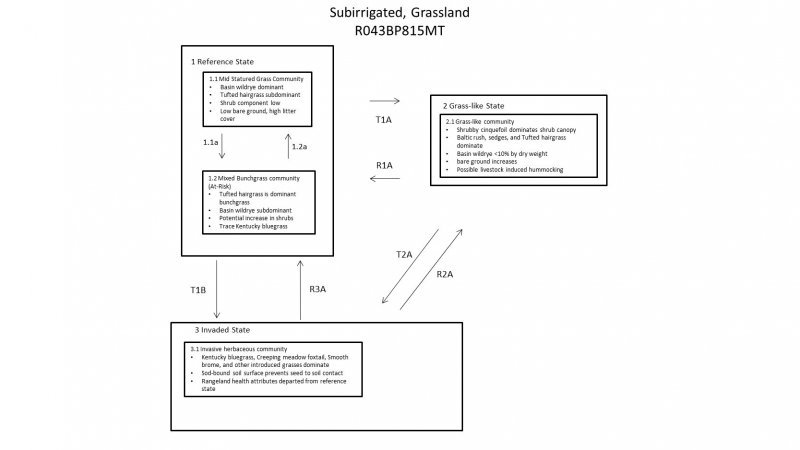
Natural Resources
Conservation Service
Ecological site R043BP815MT
Subirrigated Grassland Group
Last updated: 3/01/2024
Accessed: 12/21/2025
General information
Provisional. A provisional ecological site description has undergone quality control and quality assurance review. It contains a working state and transition model and enough information to identify the ecological site.
MLRA notes
Major Land Resource Area (MLRA): 043B–Central Rocky Mountains
The Central Rocky Mountains (MLRA 43B) of Montana occupy some 28,850 square miles and exist primarily in Central and SW portions of the state. The climate is extremely variable with precipitation lows of 9 to 100 inches per year and frost free days of less than 30 to over 110 days. The geology of the region is also highly variable. The combination of variable climate and geology create a complex relationship of plant communities. MLRA 43B elevations typically exist between 6000 and 12,799ft at Granite Peak (the highest point in Montana).
The Continental Divide runs through this MLRA effectively splitting its watershed to contribute to either the Missouri River to the East and the Columbia River to the West.
Ecological site concept
• Site receives additional water
• This site occurs on low terraces adjacent to flood plains of perennial or intermittent streams (though not in the floodplain), near springs and seeps, or other areas having a permanent or perched water table.
• Moisture Regime: ustic to udic
• Temperature Regime: frigid to cryic
• Elevation Range: 3900-7200ft
• Soils are
o Not saline or saline-sodic
o Moderately deep, deep, or very deep
o Typically less than 5% stone and boulder cover (<10% max)
• Seasonal high water table within 40” (approx. 100cm) of soil surface.
• Area of rugged mountain, hills, plateaus, and valleys of the Central Rocky Mountains in Southwest Montana.
• Dominant Cover: rangeland (grass dominated)
• Slope: 0-8% (typically less than 4%)
Site Development and Testing Plan
This Provisional Ecological Site Description was developed to meet the criteria as defined in Soil Survey National Instruction part 306 (430-306-NI, April 2015) as interpreted by Regional Ecological Site Specialist. Information in this description are first approximations based on broad groupings of soil properties and vegetation characteristics associated with those groupings. Although this description has been through the quality control and quality assurance review process it has not been certified for use in conservation planning.
Associated sites
| R043BP801MT |
Bottomland Group Bottomland site is often a neighboring site which is closest to a stream or river. The Subirrigated Grassland will be the slightly drier site however still have a water table. |
|---|---|
| R043BP817MT |
Subirrigated Shrubland Group Subirrigated Shrubland is a neighboring site and occupies the same landscape position. These two sites are often intermixed in a complex that can be hard to map separately. |
Similar sites
| R043BP801MT |
Bottomland Group Bottomland site is often a neighboring site which is closest to a stream or river. The Subirrigated Grassland will be the slightly drier site however still have a water table. The Bottomland site will express a canopy of deciduous trees and will have less soil development |
|---|---|
| R043BP817MT |
Subirrigated Shrubland Group Subirrigated Shrubland is a neighboring site and occupies the same landscape position. These two sites are often intermixed in a complex that can be hard to map separately. The Subirrigated Shrubland expresses a high deciduous shrub component made primarily of willow species. |
Table 1. Dominant plant species
| Tree |
Not specified |
|---|---|
| Shrub |
(1) Salix |
| Herbaceous |
(1) Leymus cinereus |
Click on box and path labels to scroll to the respective text.

